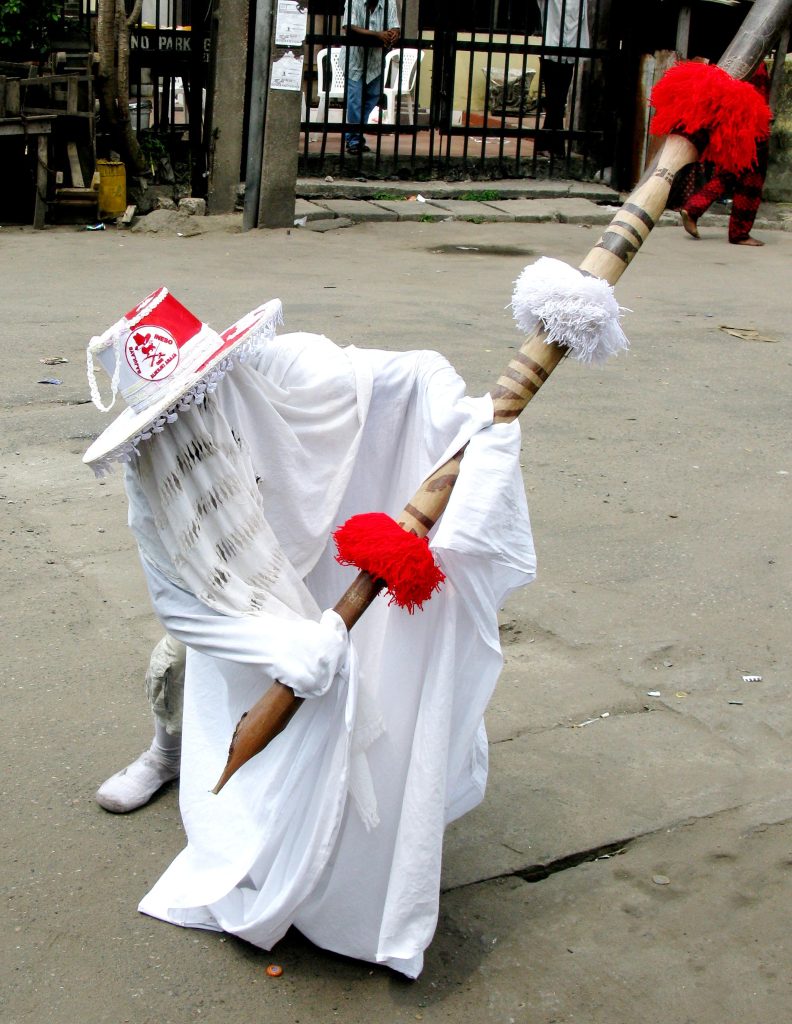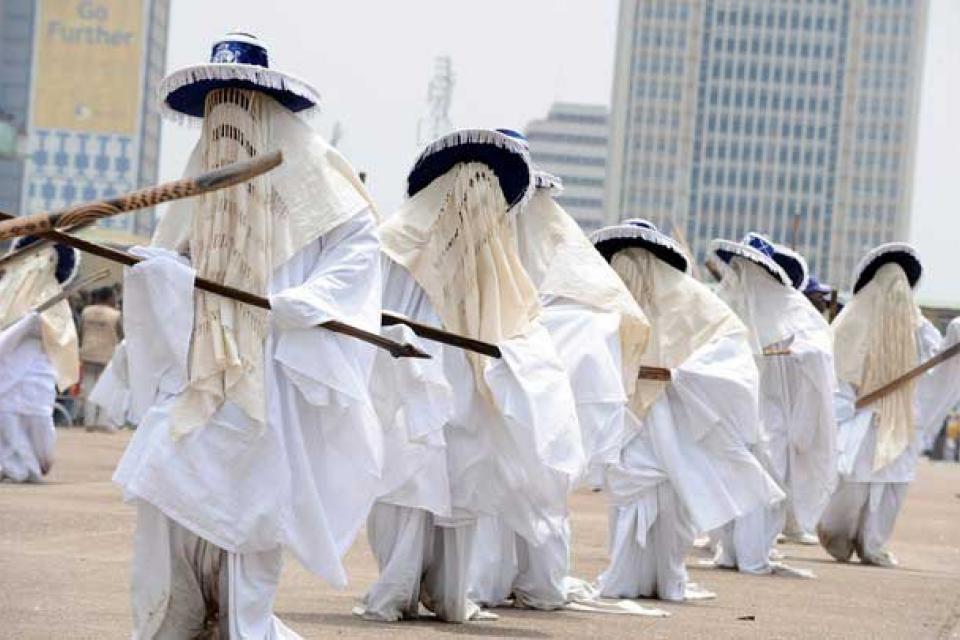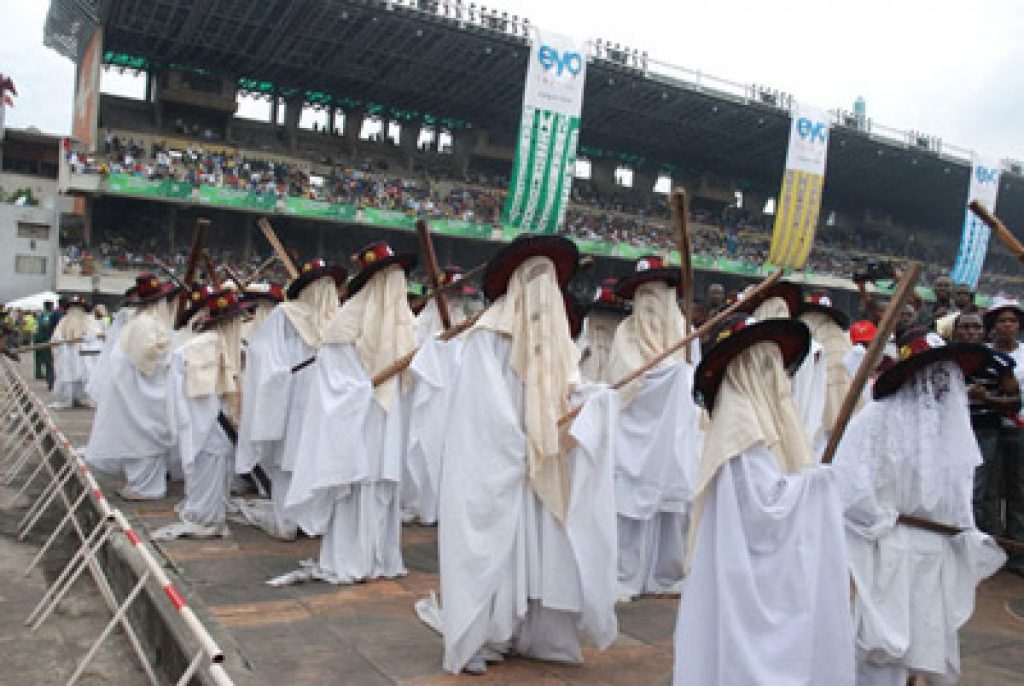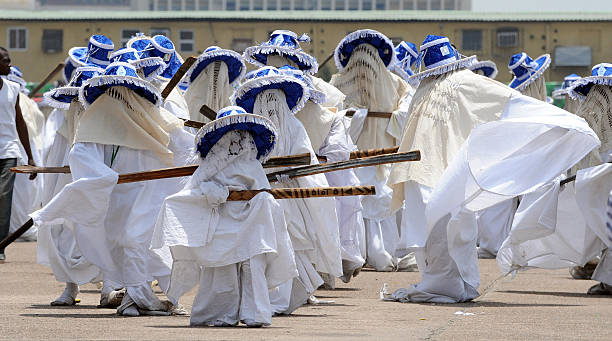Lagos, Nigeria (VOICE OF NAIJA)- The festivals celebrated by the Yoruba Indigenes in Nigeria, showcase the depth of their culture.
The Eyo festival, a Yoruba festival is a major tourist attraction in Lagos state. The Eyo festival is exclusive to Lagos, no other territory in the Yoruba land, celebrates anything like it.
The word “Eyo” refers to the masquerades that come out during the festival. Back in the day, the Eyo festival was held to escort the soul of a departed Lagos King or Chief and to usher in a new king.

More recently, the festival occurs in memory of late eminent Lagosians or to commemorate visits by State and foreign dignitaries with a parade at the Tafawa Balewa Square at Lagos Island.
Lagos is divided into two parts, Lagos Island and Mainland. The indigenes of Lagos mostly reside in Lagos Island, also known as Isale Eko, and celebrate the Eyo festival.
The Eyo festival is used to showcase the culture of the Isale Eko people. Each Eyo comes out of an Iga (palace) of a ruling family in the morning and heads for the Agodo (shrine).
The Eyo is robed from top to bottom in white flowing cloth. The white flowing costume consists of an ‘agbada’ (which is worn on top) and the ‘aropale’ (the botton that is wrapped around).
The Eyo also wears an ‘Akete’ (a hat) that bears the colours and shield of the Iga from which he comes from. An Eyo may tie ribbons, in the colours of the house that he represents, to the Opambata (palm branch) that he carries.
An Iga’s Eyo consists of about 50-100 members, although, supporters following the Eyo do not wear white robes.
The only Eyo that is not part of a group is the Eyo-Adimu Orisa, only a very old and spiritually advanced male can robe as the Adimu. It is the last Eyo to leave the “agodo.” In terms of hierarchy, Ẹyọ Adimu is above all other Eyo. There is only one Adimu and he wears a black hat.
The Eyo festival is usually held on a Saturday.
On Eyo Festival Day, the main highway is closed to traffic, allowing for a procession from Idumota to the Iga Idunganran.
The festival then comes to a climax at the Tafawa Balewa Square(TBS), where the Eyo will be on parade.

Historians claim the cultural festival was inherited from Ibefun, a town in Ogun State, where the then Oba of Lagos, Oba Akinsemoyin, set out to appease the Eyo deity so that his childless younger sibling, Erelu Kuti, can bear a child.
When an Oba of Lagos dies, it is compulsory that the Eyo festival takes place according to tradition. The family of the deceased must put a request to the Akinsiku of Lagos who is the head of the Eyos. The Akinsiku of Lagos will then request for the Ikaro, offerings, and gifts, from the family of the deceased and when the family meets this request, he distributes them among the deity families of Lagos State.
In accordance with tradition, a divination rite must follow the distribution of the Ikaro(offerings). This rite is carried out at the sacred sanctuary of the Eyo Orisa called the Awe Adimu.
At the sanctuary of the Eyo Orisa, an appropriate date is chosen for the festival to hold. When a date is selected, each of the five Eyo groups will meet to work out their plans for the festival. This meeting process must be concluded a full week before the Eyo festival day.
The appearance of the Opa is an important rite which commences a week before Eyo festival day. Each of the top five senior Eyo comes out in their hierarchical order to visit eminent individuals to inform them about the coming festival. Finally, the State Government is informed through an official visit to the Governor of Lagos State.
The night before festivities begin, tradition demands that the men assemble at the reigning Oba’s Palace for a great party. During the party, the Oba officially gives his blessings. There is another important rite that’s performed by the Eyo Laba group called the Agodo Erection Rite.
Eyo Laba conclave is the second in command of the ‘Senior Five’ Eyo conclaves. Once the erection ritual is completed, the most senior of the conclaves, the Eyo Adimu, carries out an inspection of the structure after the party has ended. Other groups of the Eyo also carry out their own inspections in hierarchical order.
There is also the observance of the ‘Gbale’ rites which symbolizes the ‘sweeping away’ of evil and the ushering in of prosperity, peace, and harmony into the state.

At 5am on the day of the Eyo festival, all the Eyos gather together to the sounds of the Gbedu and Koranga drums, two drums that are only beaten during the Eyo festival.
All the Eyos in their full regalia begin to move towards the Para, a tent built with raffia mats, erected somewhere in the neighborhood.
All the Eyos proceed to the Oba’s Palace to pay homage before moving out into the streets of Lagos Island.
The Eyos finally meet at Tafawa Balewa Square where thousands of people will be waiting to receive them and join in the festivities.
While festivities go on in a carnival-like atmosphere, the Eyo masquerades engage in dancing, singing and displaying weird acrobatic moves.




